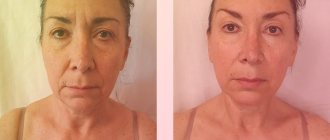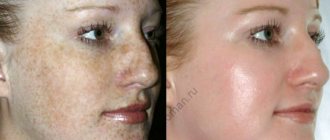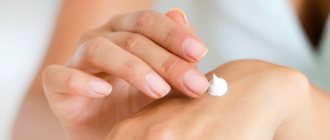Biorevitalization with hyaluronic acid is one of the most popular procedures in comprehensive facial skin rejuvenation programs. This is a unique therapeutic procedure, thanks to which it is possible to perform deep hydration, improve skin turgor and tone, restore the structure of the dermis, and restore youth and beauty to the skin. Biorevitalization, the prices of which are quite affordable, is a key procedure that allows you to prepare the skin for any aggressive influences, activate the protective functions and restorative properties of the skin. Doctors recommend starting injections of biorevitalizants from the age of 25-28 in order to prevent age-related changes that occur in the skin.
Biorevitalization of the face - the mechanism of action of the procedure
The long-term revitalizing effect of biorevitalization preparations is due to their high content of unstabilized hyaluronic acid (more than 35 times higher than the content of natural hyaluronic acid in the patient’s own skin). Hyaluronic acid molecules introduced into the skin begin to slowly break down into smaller structural units, the so-called proteoglycans and glycosaminoglycans, and then into mono- and disaccharides, which are a kind of “natural building material” for the synthesis of our own hyaluronic acid. As the main structural component of the intercellular matrix of the dermis, hyaluronic acid is responsible for skin hydration, since one hyaluronic acid molecule can hold up to a thousand water molecules.
With age, the amount of our skin's own hyaluronic acid decreases and its hydration deteriorates, which leads to a slowdown in biochemical processes and a decrease in the rate of division of cellular elements of the basal layer of the skin. This mechanism underlies one of the causes of skin aging. Thanks to biorevitalization, today it is possible to slow down the aging process, since as a result of the procedure, the balance of the skin’s own hyaluronic acid is restored. The result is that the water balance is normalized, and the cells receive ideal conditions for life.
How is the biorevitalization procedure performed?
Due to the fact that the procedure is performed using local anesthesia cream, it is practically painless. Injections are made into the face, neck, and décolleté. The course of treatment is determined by the doctor individually for each patient and usually contains from two to four procedures with an interval of once every two weeks, depending on the skin type and the severity of age-related changes. The duration of the effect is one year. In some cases, maintenance procedures are recommended to restore the skin after aggressive external influences.
After the procedure, small papules (nodules) remain on the facial skin, which resolve on average within 2-3 days.
Opinion of cosmetologists
The cosmetologist talks about the need to complete a full course during biorevitalization in this review. He notes that only in this case should one expect a good effect.
A dermatocosmetologist talks about the fact that you shouldn’t inject fillers and biorevitalizers on the same day in this review. He says that it is better to take a break between procedures of up to 4 weeks. Otherwise, there is a risk of distorting the final result and reducing the duration of the filler due to the activation of hyaluronidase.
The next cosmetologist also says that it is possible to combine fillers and biorevitalization. Notes that everything is allowed to be done in one day. But he doesn’t recommend it, since it will put an additional burden on the body and the biorevitalizer can reduce the duration of the filler.
The rate of resorption of papules depends on the following factors:
- Concentrations of hyaluronic acid in the preparation. The higher the hyaluronic acid content, the longer the papules last.
- Patient's skin hydration. Let me remind you that the first stage in the skin is the decomposition of hyaluronic acid into smaller saccharides, from which our own will subsequently be synthesized. This process occurs under the action of the enzyme hyaluronidase, is called hydrolysis and requires the presence of water. The better the skin is moisturized, the faster hydrolysis occurs, the faster the papules disperse. Thus, the duration of resorption of papules is an indirect diagnostic sign of the level of moisture in various areas of the skin. That is why on young skin with good turgor, papules last much less than on thin, dry skin.
- Individual hyaluronidase activity.
- External influences that increase blood flow to the face, such as a sauna, steam bath, local warming agents, and physiotherapy, accelerate the resorption of papules.
Facial mesotherapy and biorevitalization. What are the differences?
There is often a misunderstanding about the difference between biorevitalization and mesotherapy procedures. These are similar injection procedures aimed at rejuvenation, increasing skin hydration and elasticity, and smoothing wrinkles. The difference in the effect of these procedures is determined by the drugs administered.
The biorevitalization procedure uses pure hyaluronic acid of non-animal origin in a very high concentration, which is capable of breaking down in the skin into individual structural components from which its own hyaluronic acid is synthesized. This results in a powerful moisturizing effect, as well as a long-lasting result, which is maintained due to an increase in the reserve of the skin’s own hyaluronic acid, and not due to the action of the drug.
The mesotherapy procedure uses hyaluronic acid of animal origin, which is different from ours and therefore cannot be integrated into the structure of the skin. The moisturizing effect lasts as long as the drug itself is in the skin, and hyaluronic acid attracts water, so the duration of the effect is insignificant and is no more than 7 days. However, mesotherapy preparations contain many other nutrients: vitamins, amino acids, antioxidants, which provide an instant radiant effect. Thus, the effect of mesotherapy occurs quickly, but the effect is more short-term, which requires a long course of procedures to achieve a lasting result. Therefore, this procedure is ideal as a prevention of age-related changes and is indicated for young skin up to 40 years of age.
Biorevitalization, on the contrary, gives a long-term result, but the effect occurs gradually, since it takes some time to synthesize the skin’s own hyaluronic acid. Usually a course of 3-5 procedures is carried out once a year. Biorevitalization is ideal for aging skin after 40 years. It should be noted that the biorevitalization procedure can be used to increase tone and elasticity in any area of the skin of the body. It is successfully used to treat the skin of the hands, abdomen and intimate area.
Fillers and laser treatments – when is this combination possible?
Fillers and laser resurfacing are a great combination of treatments for skin rejuvenation. Their combined effect is associated with the impact on different skin layers:
- Fillers work deeper than the laser, filling folds, deep wrinkles and correcting facial features.
- Resurfacing – removes the top layer of skin along with old cells, age spots, superficial wrinkles, and acne marks.
Although the combination of these two methods works great, cosmetologists advise doing laser resurfacing first and only then injecting filler. The results of using fillers may change due to thickening of the skin after the laser. This effect is caused by an increase in the production of collagen and elastin proteins, which form the basis of the skin.
Deeper laser treatments do not work well with filler injections. The laser tends to heat the water, causing it to evaporate, so the filler may be destroyed during the procedure.
The laser does not have a negative effect on all fillers:
- Preparations based on hyaluronic acid are sensitive to laser beams, since their action is based on the ability to attract liquid. The laser heats the water, which causes it to evaporate and reduce the effectiveness of the filler.
- Fillers based on polylactic acid are injected deeper, so the laser does not reach them, and the likelihood that the drug will be destroyed during the procedure is extremely small. In addition, the action of these substances is not based on the attraction of water, so laser beams have little effect on them.
- Fillers based on calcium hydroxyapatite are less susceptible to laser exposure. They are deeply inserted, do not attract water and have a dense structure that the laser beam cannot affect.
This was confirmed by studies conducted in the USA and Israel, which tested the laser resistance of popular fillers.
You should inform your cosmetologist about your desire to combine laser procedures and the introduction of fillers, who will select a drug that is not destroyed by the laser.
Combination of filler and laser resurfacing before and after
Biorevitalization and contour plastic surgery. What's better?
Confusion often arises between biorevitalization and contouring procedures, since both use hyaluronic acid of non-animal origin, identical in structure to our own. So what's the difference between them? Let's try to figure it out. In biorevitalization, the so-called unstabilized HA is used, that is, not held together by additional bonds between molecules. Thus, upon entering the skin, such a drug is immediately exposed to the enzyme hyaluronidase, breaking down into “structural units”. That is, the drug itself remains in the skin for no more than 3-7 days, and the effect is due to the synthesis of its own HA and moisturizing the skin. In contouring procedures, stabilized HA is used, that is, “cross-linked” with many intermolecular and intramolecular bonds that prevent its destruction by hyaluronidase. As a result, the effect is due precisely to the presence of the drug in the skin, which allows you to restore tissue volume and fill wrinkles and folds. Thus, the mechanism of action and purpose of these procedures are fundamentally different from each other. Separately, I would like to note that different types of HA combine well with each other and enhance each other’s effects.
HA - hyaluronic acid.
What are fillers and when is their use appropriate?
Fillers (from the English “fill” - “fill”) are used in contour plastic surgery and are gel-like preparations that are intended for:
- filling wrinkles and deep skin folds;
- shaping (sculpting) the oval of the face, chin, etc.;
- adding volume in the necessary places - lip augmentation, etc.;
- skin tightening;
- eliminating asymmetry.
The effect of fillers lasts from several months to several years.
Attention! This is an ideal option for loose, sagging skin with obvious signs of aging, as well as for asymmetrical facial contours.
Biorevitalization of lips
Biorevitalization of the lips allows you to moisturize, restore the tone, color and richness of the lips without increasing their volume. This procedure is indispensable for patients suffering from atopic dermatitis, cracks in the corners of the mouth, as well as any inflammatory diseases of the lips (cheilitis) of an infectious nature, including bacterial and viral origin. Also, lip biorevitalization will help restore lips after aggressive exposure to the sun or cold, so it is recommended to do it after a trip to the sea or to the mountains. The number of procedures is selected individually and averages 2-3 procedures with an interval of 14 days. As a rule, preparations with a volume of 0.5-0.6 ml are used.
Preparations for biorevitalization
Our center presents the following lines of drugs for the Biorevitalization procedure: Ial-System, Teosyal, Skin Fill, Rugantil, Gialax. The volume of preparations is 0.6, 1, 1.5, 2 and 3 ml. The amount of the drug is selected individually depending on the severity of age-related skin changes, skin type and the desired area of influence. As a rule, 1 ml is enough for the face, 2 ml for the face and neck, 3 ml for the face, neck, décolleté and hands. To rejuvenate the area around the eyes, 0.6 ml is used. The number of procedures ranges from 2-5 with an interval of 2 weeks.
Please note that this article is of a general educational nature and cannot be used for the patient to independently prescribe procedures or select a drug. Only a dermatocosmetologist has the opportunity to assess the condition of your skin and choose the right drug for you and the duration of the course of procedures. That is why the initial appointment for the procedure is always accompanied by a consultation with a doctor.
Author: Cosmetologist, Lachinova Natalya Mikhailovna
ALL RIGHTS RESERVED. COPYING OR QUOTING INFORMATION WITHOUT POSTING A DIRECT LINK IS PROHIBITED.
Fillers and radiofrequency treatments
Radiofrequency exposure is a common technique used to sculpt the face and body. Scientific studies conducted at the Amore Pacific Corporation Research and Development Center, Yongin, Korea and Seoul University have shown that the injection of fillers after exposure to radio waves produces good results. However, in this case, you need to wait for tissue recovery after the procedure.
During radiofrequency treatment, excess fat cells are removed, which causes the effect of liposuction. However, in some areas it is necessary to add the missing volume using fillers, so cosmetologists actively use them.
Skin tightening after radiofrequency treatments has a beneficial effect on the results obtained with fillers, especially those containing hyaluronic acid. Combined rejuvenation prolongs the period of stay of the filler in the tissues and reduces the volume of filler required to obtain the desired result.
Combination of filler and radiofrequency treatments before and after
The use of radio frequencies together with filler helps get rid of deep wrinkles and maintain the results for as long as possible.






